Both GoTo and PushTo telescope systems allow us to easily locate objects in the night sky, which can be a huge benefit for any telescope, including Dobsonians. It’s no surprise, then, that many of the top GoTo and PushTo telescopes we recommend happen to be Dobsonian telescopes.
My Special Note:
If you could get a larger aperture manual telescope than a GoTo/PushTo Dobsonian at the same price (provided such a telescope is still manageable for you), I’d strongly advise you to get the larger telescope. A larger telescope’s capabilities arguably eclipse the advantages of computerized pointing.
However, if you’ve more or less arrived at the maximum aperture you can handle and can appropriately budget for accessories like eyepieces, filters, and a battery, then by all means spring for a computerized Dobsonian. I’d do the same.
I’ve even converted some of my dobsonian telescopes to PushTo systems by simply attaching the bracket from a Celestron StarSense Explorer PushTo telescope with some jerry-rigged or 3D-printed contraption. You can also do it relatively easily with an aftermarket hardware kit from AstroDevices.
GoTo Tech is a little more difficult to add to an existing telescope. I found most aftermarket kits to be cost-effective only for large (14–16” and up) instruments.
PushTo Dobsonians: The Basics
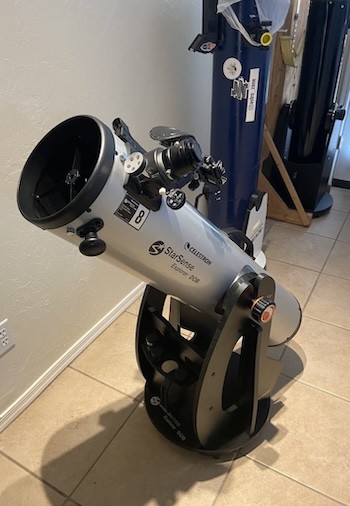
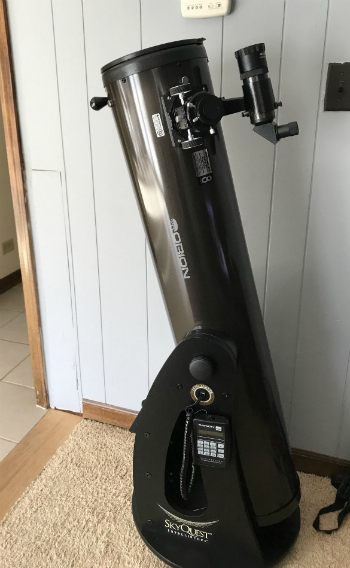
PushTo telescopes like the Orion IntelliScope or Celestron StarSense Explorer Dobsonians don’t automatically point at objects for you. The aim and function of these PushTo systems is to act as a sort of map or celestial GPS to get you to your target object. It’s still your job to manually push the telescope there.
PushTo telescopes use a physical data encoder or a camera/gyroscopes (such as those already found in our phones) to track the position of the telescope relative to the night sky. This is done in real time after a short alignment process. By knowing where the telescope is aimed in the sky at all times, software in an attached hand controller or your smartphone/tablet will produce arrows and other indicators on screen to guide you towards your target.
Newer PushTo systems, like the Celestron StarSense Explorer system, don’t use any positional encoders at all. Instead, its PushTo system relies on our smartphone’s camera to calibrate on a known set of stars every so often. And then it uses our phone’s internal gyroscopes to keep track of the position in between these exposures.
Advantages and Disadvantages of PushTo System
- PushTo telescopes are great in that the system is entirely optional to use. There is no penalty for not powering up the electronics; you can simply aim the telescope as-is manually.
- For PushTo systems, you typically don’t need external batteries. The power consumption of a hand controller or using your smartphone as the controller is very low.
- You can aim your telescope manually and use the PushTo system when you need help with a hard-to-find object or are lost.
- Without any bulky motors involved, your PushTo telescope is not any heavier or more inconvenient to set up.
However, PushTo systems are limited in their capabilities.
My Special Note:
I never found the relative lack of precision I usually get with PushTo to be a problem when I am hunting down Messier or Herschel 400 objects with an 8” or 10” Dobsonian. But with bigger telescopes—say, a 16″—it can be annoying when we’re trying to locate fainter and smaller objects, especially if the telescope itself has a rather limited field of view.
In the case of older hardware encoders, I simply don’t get enough resolution. An 8192-step encoder sounds impressive until we consider that in a 360-degree circle, a 1/8192 fraction corresponds to about 5 times the apparent size of Jupiter, or 1/20 of a degree. 40k or even 120k-step encoders solve this problem, but the price for these higher-resolution encoders can get steep.
The accuracy of newer PushTo systems is primarily limited by our phone’s camera and gyroscopes. Also, there is bound to be some mechanical play or misalignment between the completely external plate-solving system, like our phone, and our telescope itself.
The Celestron StarSense Explorer app just declares us to be on target once we are within about ¼ to ½ of a degree (between ½ and the full extent of the Moon or Sun in the sky). Our smartphone’s onboard gyroscopes probably can’t provide much better accuracy than that anyway. Part of the reason for the StarSense Explorer’s limited accuracy with even the highest-end smartphones, such as my iPhone 14 Pro, could just be the software itself rounding numbers or using relatively compressed images of the sky to save on battery and processing power. For many smartphones, however, hardware limitations are more of a bottleneck.
The AstroHopper and other third-party phone-based systems, from what I’ve experienced, are substantially less accurate than the Celestron StarSense Explorer or most encoders. This is more due to the fact that there is no standard, rigid bracket to secure our phone to our telescope to use with these programs. For this reason, I do not particularly recommend AstroHopper. The accuracy AstroHopper tends to provide with most jerry-rigged setups is poor enough that we’re better off just learning to navigate the sky yourself.
There are other, substantially more accurate plate-solving systems that run on a dedicated camera, like the PiFinder. PiFinder is a DIY project in and of itself. But whenever I use it, it takes a substantial amount of time to plate-solve—sometimes as long as a minute per capture. This pretty much removes the point of using PushTo to save time in finding a target, albeit still accomplishing the task.
We’ll constantly have to manually nudge our telescope to keep objects in the field of view, as we would with a completely manual one.
You can put your PushTo telescope atop an equatorial platform and get automatic tracking that way. But from my experience, not all PushTo systems are designed to be compatible with the tilt induced by an equatorial platform as it tracks. Plate-solving systems like the Celestron StarSense Explorer keep up just fine. But with encoder-based systems, we may need to program in some settings to compensate for the platform’s tracking.
GoTo Dobsonians: The Basics
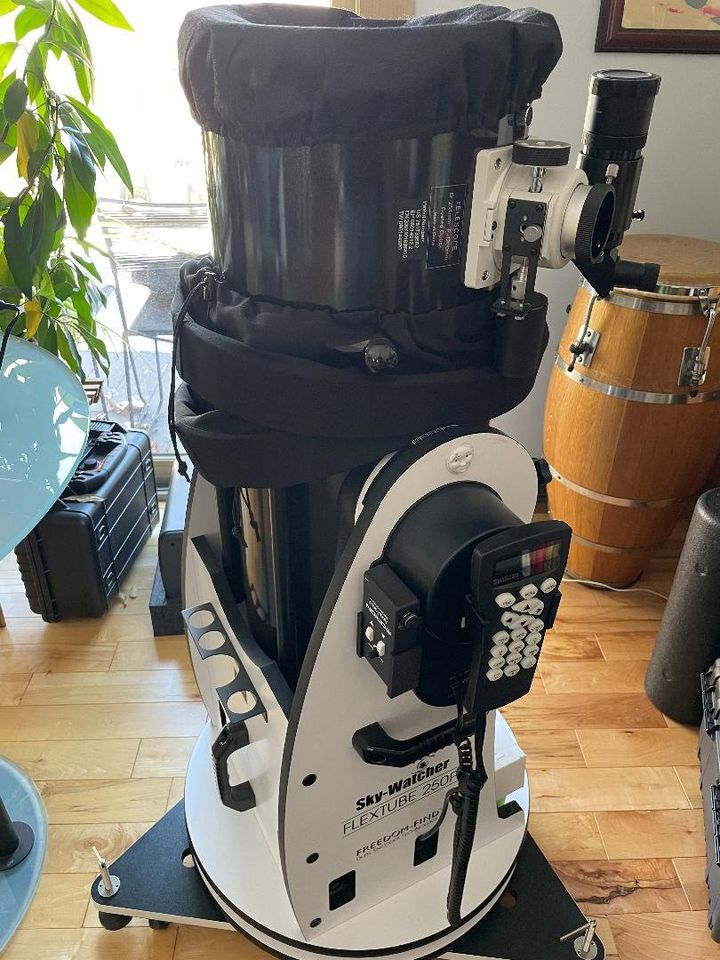
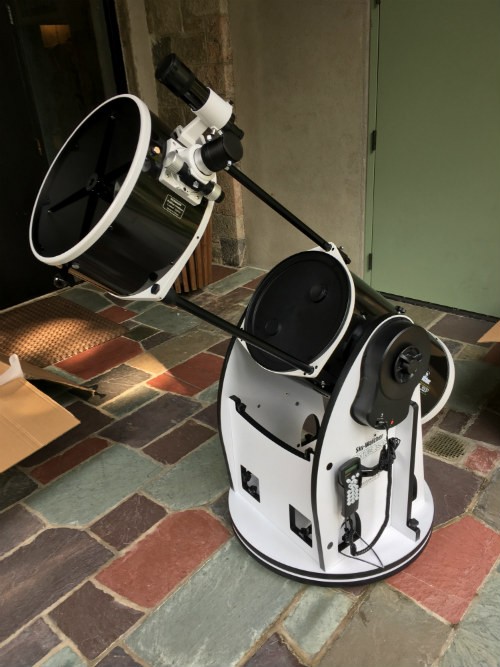
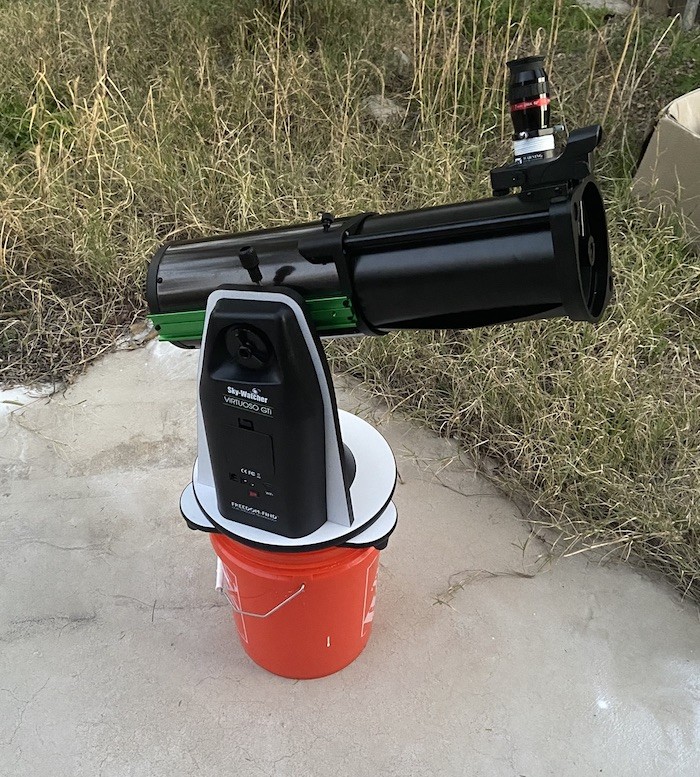
GoTo telescopes use motors to automatically push the telescope around the sky and then automatically track the target object as the Earth rotates around its axis.
The constant utilization of powerful motors means that a GoTo Dobsonian will use a lot more electricity than any PushTo system. 8” and larger GoTo Dobsonians need a beefy external power supply or direct access to an AC outlet to run for any reasonable length of time.
The good news is that many GoTo Dobsonians sold today will allow us to grab and manually aim the telescope without any ill effect on the positional accuracy. This means that GoTo Dobsonians can be aimed manually to save power for large movements around the sky. There is no need to stop our observing session if power is lost or unavailable.
To cut costs, some non-Dobsonian GoTo telescopes and mounts lack this feature of manually aiming without disrupting their GoTo/tracking functions. I’ve personally used some GoTo telescope mounts that literally cannot move on at least one axis without power.
Which is More Cost Effective and Useful: PushTo or GoTo?
At smaller aperture sizes, the usefulness of GoTo and PushTo really depends on who you ask.
I’ve plenty of experience stargazing and believe me when I say that the majority of the deep-sky objects you can see with a smaller telescope (say, 4-6” in aperture) are relatively easy to locate. The wide field of view of most tabletop Dobsonians also aids in this process. Thus, I consider PushTo with relatively small telescopes to be really more of a crutch—a way to learn your way around the sky at first until you don’t need it anymore.
At larger apertures, PushTo tends to be the more affordable choice. The required PushTo hardware (and thus the cost) is the same at pretty much any size.
In the case of GoTos, the larger the telescope, the more powerful/accurate the motors have to be. This leads to huge increases in cost and weight.
The Comparison Table
Price (6”):
Price (6”):
Price (16”):
Power Consumption:
Weight added by electronics:
Automatic Tracking:
Can be aimed manually:
Pointing Accuracy:
Database of deep-sky objects:
Manual Dobsonians
$300
$1000
$3600
A couple small batteries for your finder and maybe a dew heater
Nil
No
Yes
Unlimited
Your brain can memorize the positions of several hundred objects in the sky in just a few months of practice. Books, SkySafari, and analog charts are all you really need.
PushTo Dobsonians
$500
$1500
~$4000
Minimal, usually just a few AA batteries or your smartphone’s own power
No more than a pound or two
No
Yes
0.3-0.5° typical, 0.1-0.2° with higher-end encoders
Self-contained units, e.g. IntelliScope and the StarSense Explorer app, are limited to well-established catalogs from databases, e.g. NGC, IC Essentially unlimited if using a device paired with SkySafari or if programmable.
GoTo Dobsonians
$500
$2500
$4680
High; need dedicated power supply for 8” and larger GoTo scopes
20–30% weight gain is typical
Yes
Usually yes
~0.1° or better with good alignment
Essentially unlimited if used with smartphone/tablet apps or PC control.
GoTo SCTs (Celestron/Meade)
$1000
~$3500
~$15000
Similar to GoTo Dobs, need a dedicated external power supply for 6–8″ and larger scopes/mounts
Motor/drive systems can make up the majority of system weight
Yes
Almost never
~0.1° on most commercial mounts with good alignment; better if plate solving
40,000 objects in most hand controllers, of which around 30,000 are either stars or not visual targets. WiFi dongle with SkySafari, or PC connection, allows essentially unlimited database.
My Top Computerized Dobsonians Picks, Sorted By Price
Cheapest/Most Portable PushTo
StarSense 114
Under $375
The Celestron StarSense Explorer 114mm Tabletop Dobsonian is quite literally a Zhumell Z114 (MRSP: $240) with Celestron’s StarSense Explorer bracket strapped to the side of its altitude axis. You could get a larger scope for the money, but the StarSense Explorer technology is extremely helpful in locating targets throughout the night sky.
- Wide-field views as well as sharp lunar, planetary performance like other 114mm tabletop Dobsonians
- StarSense Explorer app/bracket are a breeze to use
- Extremely lightweight/compact
At the eyepiece, the StarSense Explorer 114mm Tabletop Dobsonian is just like its manual counterparts, the Zhumell Z114 and Orion StarBlast 4.5 Astro. It is not to be confused with the tripod-mounted StarSense Explorer 114AZ, which is a Bird-Jones with vastly inferior performance on account of its poor optical design.
The StarSense Explorer 114mm Tabletop Dobsonian is designed for use on a tabletop but can be attached to a DIY tripod/stand or Celestron’s own aftermarket tripod, which fits all three of the StarSense Explorer tabletop Dobsonians (114mm, 130mm, and 150mm) as well as other tabletop scopes.
The StarSense Explorer bracket/app took just a few minutes to set up and align with the telescope. For me, aiming the scope was a breeze. The tabletop Dobsonian mount stays where I aimed it when I let go of it.
You will want to purchase some better aftermarket 1.25” eyepieces than the included pair of Kellners (17mm and 10mm for 26x and 45x, respectively). Neither is the sharpest or particularly comfortable to look through, and 45x is far too low of a magnification for close-up planetary viewing. 100–200x is more appropriate with this telescope.
While the 450mm focal length makes this scope ideal for wide-field viewing of deep-sky objects like open star clusters and large emission nebulae, aftermarket high-power eyepieces that I’ve in my collection provided excellent views of the Moon, planets, and double stars too.
Cheapest/Most Portable GoTo
Virtuoso 130P
$375-$450 Range
While the Virtuoso GTi 130P is an excellent telescope, the form factor and cost of the larger, but not much more expensive Virtuoso GTi 150P are hardly different at all. The 150P offers much better performance at the eyepiece. Our in-depth comparison between the Virtuoso GTi 130P and 150P explains more.
- 130mm f/5 optics for excellent views of Solar System and brighter deep-sky objects
- Fully motorized GoTo/tracking controlled via your smartphone or tablet
- Tabletop but can be attached to any ⅜”-16 compatible tripod
The Sky-Watcher Virtuoso GTi 130P is based on the manual Heritage 130P model, with an identical optical tube and accessory set. I’ve had the chance to use both telescopes. The major difference lies in the upgraded Virtuoso GTi mount, which features full GoTo with automatic pointing and tracking. I also noticed that the GTi 130P’s mounting is a fair bit wider/bulkier than that of the Heritage 130P.
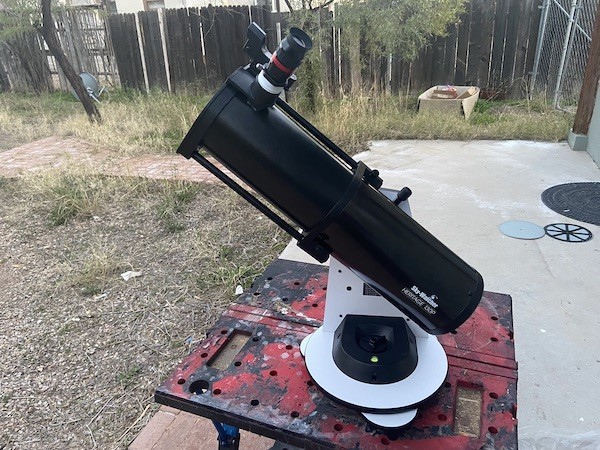
Like the other GoTo Dobsonians featured in this article, the GTi 130P features dual encoders (branded “FreedomFind” by Sky-Watcher) and slip clutches. This means we can manually aim the telescope, whether powered off or on, without any concerns about wear to the gears or loss of GoTo/tracking accuracy.
The GTi mount is operated wirelessly via our smartphone/tablet and the SynScan app. You can buy a hand controller aftermarket and plug it in if you wish.
The Virtuoso GTi 130P is quite portable thanks to its collapsible tube. You can use the Virtuoso GTi 130P on a tabletop. If you want to use it atop a sturdy tripod, it has a ⅜”-16 threaded socket on the underside of the base as well.
You get two 3-element eyepieces with the 130P: a 25mm (26x) and a 10mm (65x), which I found to be working quite well with this telescope. The Virtuoso GTi 130P’s pair of included eyepieces are more than adequate to start, but you’ll want to purchase additional ones for a greater range of magnifications.
You may also want to construct a shroud for the open-framed tube.
Best Value Tabletop GoTo
Virtuoso 150P
$450-$700 Range
With quality optics, well-made included eyepieces, and the ability to be used manually even while the mount’s electronics are powered on and aligned with the sky, it’s hard to argue against the Virtuoso GTi 150P, especially at a price on par with most manual telescopes of its aperture.
- 150mm f/5 optics provide brighter, sharper views than 130P model with minimal increase in weight, bulk, or price
- Fully motorized GoTo/tracking with FreedomFind encoders, all controlled via your smart device
- Collapsible tube significantly improve portability over solid-tubed 150mm models
Like its smaller counterpart, the Virtuoso GTi 130P, the Virtuoso GTi 150P merges the Heritage 150P‘s quality optics and collapsible tube, offering excellent value. Its 150mm aperture surpasses the 130P in light gathering by 40% and in resolving power by 20%. But thanks to the collapsible tube of the 150P and the shared mount between the scopes, I didn’t find any difference in portability when I used these. The increase in weight amounts to all of a couple pounds, which I didn’t find much difficulty with.
Like the 130P, the Virtuoso GTi 150P has a 1.25” focuser. In spite of the limitation to only 1.25” accessories, the 750mm focal length of this scope means that it still provides a broader maximum field of view compared to a 6” f/8 Dobsonian or a typical 8” f/6 that sits on the ground.
As with the 130P and Heritage 150P, you get 25mm and 10mm 3-element eyepieces providing 30x and 75x, respectively, along with a collimation cap and a red dot finder for manually aiming the telescope.
Compact when disassembled, the Virtuoso GTi 150P is able to fit in a suitcase or large backpack. It can be used either atop a sturdy stand/table or a regular tripod with a ⅜” stud.
As with the 130P, creating a shroud for the 150P’s open tube is a must, and investing in a couple of extra eyepieces to get the full range of useful magnifications with this telescope wouldn’t hurt either.
Best 8″ PushTo
StarSense 8″
$700-$1000 Range
Any 8” Dob puts up excellent views, and the StarSense Explorer 8” is no exception. The only downsides, when compared to its manual counterparts, are its price and lack of accessories.
- 8” primary mirror provides far more light-gathering/resolving power than smaller telescopes
- StarSense Explorer technology makes navigating around the sky simple and intuitive
- Big enough to sit on the ground, there is no need for a tripod or table
- The lightweight base and built-in carry handles make the StarSense Explorer 8” considerably more portable than competing 8” Dobsonians, e.g. Apertura AD8
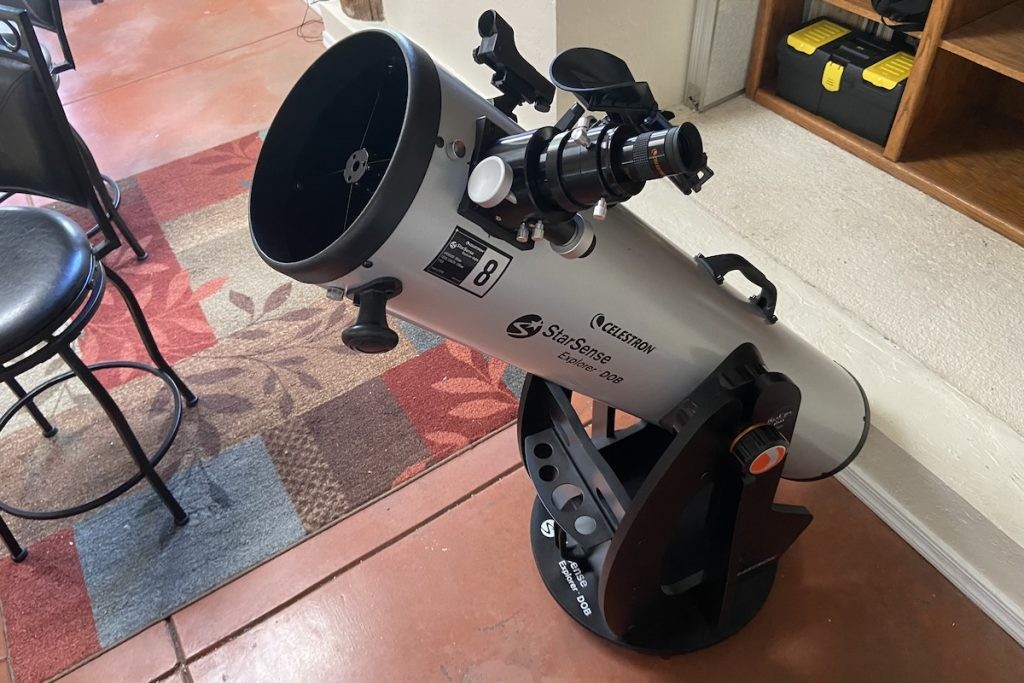
The Celestron StarSense Explorer 8″ Dobsonian, like its smaller tabletop and tripod-mounted counterparts, is a PushTo telescope that utilizes our phone’s onboard camera and gyroscopes to determine where it is aimed in the sky.
Any 8” Dob puts up excellent views, and the StarSense Explorer 8” throughout the period that I used it was no exception.
However, we only get one eyepiece (a 25mm Plossl yielding 48x) to start with, and the focuser is a single-speed design. A red dot finder is also provided as a backup to the StarSense Explorer app/bracket.
Celestron does include a collimation cap with all of the StarSense Explorer Dobsonian telescopes to make the process easy. But the 8” Dobsonian model requires a screwdriver to adjust the primary mirror (as do its Sky-Watcher 8” Dobsonian counterparts), which I find to be a bit of an inconvenience.
In addition to the extremely easy-to-use StarSense Explorer technology, what I think separates the Celestron StarSense Explorer 8” Dobsonian from other 8” Dobs is its lightweight Dobsonian base. Celestron has shaved off as much bulky particle board as possible to keep weight down, and cutouts in the base act as carry handles.
The tube of the StarSense Explorer 8” and larger models also features carrying handles and a handle attached to the end of the tube for aiming. Other 8” Dobsonians would require you to make your own lightweight base and drill holes to add handles to the tube.
If you don’t mind shopping for some aftermarket eyepieces and perhaps a cooling fan, there is no other 8” Dobsonian as convenient to use out of the box as the Celestron StarSense Explorer.
Best 10″ PushTo
StarSense 10″
$1000-$1200 Range
Like its 8″ counterpart, the Celestron StarSense Explorer 10″ Dobsonian has a lightweight base, built-in handles, and Celestron’s superb StarSense Explorer tech bundled in. As with the 8″, the only downsides are its price and lack of accessories.
- 10” aperture provides bigger and brighter views than an 8” with minimal difference in weight, bulk, inconvenience to store/transport
- StarSense Explorer database is ideal for hunting down faint galaxies
- Lightweight base and convenient carry handles improve portability
As with the 8” model, we also don’t get much else; just a single 25mm Plossl eyepiece (48x) and collimation cap are included, along with a red dot finder if we don’t want to use the StarSense Explorer app.
The StarSense Explorer 10” Dobsonian isn’t cheap, but it offers the best value overall among the three larger StarSense Explorer Dobsonians, all of which I’ve used personally.
I like that the lightened base and built-in handles of the StarSense Explorer 10” make it considerably more portable than other solid-tubed 10” models (though there are a variety of truss or collapsible 10” telescopes that are even more so).

It might come as a surprise to you, but I’ve confirmed that this telescope is about the same physical size and weight as its smaller 8” counterpart.
The views with this much aperture are amazing, especially under a dark sky where you can view detail and structure in individual galaxies, resolve faint globular clusters into their stellar components, and reveal the dazzling blue and green hues of planetary nebulae.
Best 12″ PushTo
StarSense 12″
$1200-$1500 Range
The largest of the StarSense Explorer Dobsonians, the Celestron StarSense Explorer 12” is a monster solid-tube design, similar to manual competitors like the Apertura AD12.
- 12” f/5 optics collect even more light than a 10”, ideal for deep-sky viewing
- StarSense Explorer technology makes aiming even this behemoth solid tube easy
- Lightweight base and carry handles vastly improve portability over competitors
The tube of this scope is a bulky, 5-foot (1.5m) long cylinder that weighs as much as a small child. Be sure you can handle such an item taking up space in your home/car before purchasing.
The good news is that the base of the StarSense Explorer 12” features a minimalist, lightweight design and is vastly easier to haul around than that of competitors that I’ve used.
If you pick the tube up properly, it usually isn’t that difficult for healthy adults to carry around the StarSense Explorer 12” optical tube, and Celestron has aided the process by bolting on some handles. If you’re primarily going to use this telescope at home in the driveway or backyard, I’d recommend a dolly or hand truck as a wise additional investment.
As with the other StarSense Explorer Dobsonians that I’ve had my hands on, the 12” model isn’t particularly well-accessorized either; just a single 32mm Plossl eyepiece (47x) is included along with a basic collimation cap.
The focuser is a single-speed unit, and no fan is attached behind the primary mirror to cool it down faster. Adding a fan to this telescope is a must in most climates, if you ask me.
You’ll want to budget appropriately for upgrading your eyepiece collection and perhaps to a dual-speed focuser unit.
However, if you’re not afraid of such investments or its sheer size, the StarSense Explorer 12” Dobsonian is well worth putting up with.
Lunar and planetary detail is jaw-dropping with a 12” telescope when atmospheric conditions permit, and Pluto is visible even from the suburbs. Under a dark sky, you can go after thousands of faint galaxies, and the Orion Nebula begins to transform from appearing purely black-and-white into an array of subtle green and blue color tones.
Best 10″ GoTo
SkyWatcher 250P
$1500-$2000 Range
The Sky-Watcher 10” FlexTube GoTo Dobsonian, or FlexTube 250P, offers a big 10” primary mirror, as well as motorized tracking and GoTo with FreedomFind encoders and compatibility with the SynScan app built in, just like the Virtuoso GTi telescopes.
- 10” f/5 optics for bold and bright views of all types of objects
- More compact when stored than many manual 10” models, thanks to FlexTube’s design and optimized base
- GoTo Dobsonian base can be aimed manually, with provided hand controller, or with the SynScan app on your device of choice
We get a SynScan hand controller should we not want to use your smart device to control the telescope (supply chain issues meant that there was a period throughout 2022–23 where some units had only WiFi or a SynScan handset and not the other, but this has passed).
The FlexTube design doesn’t save much weight over a conventional solid-tubed 10” Dobsonian, but it does help reduce the volume of this scope when we store it or if we are lacking in care space.
The 10” FlexTube GoTo Dobsonian’s large aperture and motorized tracking also make it ideal for planetary astrophotography, mimicking the performance that I’ve seen with catadioptric telescopes such as the Celestron C9.25 or C11. You will need a 3x or even 5x Barlow to reach sufficient image scale with most planetary cameras, however.
As with the smaller Heritage/Virtuoso GTi 130P and 150P, we do need a shroud for the FlexTube 250P to keep dew and stray light out of the tube in most cases. Either sewing our own or picking up one aftermarket should be our first priority after ordering the telescope itself. I almost always use a shroud.
Thankfully, Sky-Watcher does include two decent 1.25” Plossl eyepieces (25mm and 10mm, yielding 48x and 120x, respectively, with this telescope), and a 9×50 right-angle straight-through finder is provided for alignment (a bit overkill if you ask me, but nice to have).
The 10” FlexTube GoTo Dobsonian is considerably heavier than a manual or PushTo 10” thanks to the thicker boards and heavy motors used on its base. I can’t pick it up in one piece and carry it around like I could with the manual 10” FlexTube or StarSense Explorer 10” Dobsonian. However, the tube is not any heavier than its manual counterpart, and the base on its own is still pretty easy to pick up and move around. We can always just put the whole scope on a dolly if you need to move it a longer distance.
Best 12″ GoTo
SkyWatcher 300P
$2000-$3000 Range
Sky-Watcher’s 12″ Flextube GoTo Dobsonian offers improved portability over traditional solid-tubed 12″ models thanks to its collapsible tube, which is much more of a practical improvement at this aperture compared to the 8” and 10” FlexTube Dobs.
- 12” f/5 optics for stunning deep-sky views, especially under dark skies
- FlexTube design significantly improves portability over solid-tubed 12” Dobs
- Large aperture and GoTo make it ideal for planetary imaging as well as visual observations
The 12” FlexTube GoTo Dobsonian’s base and collapsed tube are both fairly heavy. But I don’t have much trouble fitting this scope in most cars, which is not necessarily true with a solid-tubed 12” like the StarSense Explorer or Apertura AD12. This is a big consideration if you are far from a clear, dark sky with little light pollution, since you’ll want to transport your telescope to a better viewing site to get the most out of it.
Although equipped with only a single-speed focuser and basic Plossl eyepieces to start you out with, the 12” FlexTube GoTo Dobsonian delivers us the remarkable views expected from any other 12″ Dob and includes a 9×50 finder for aiming/alignment purposes.
Like the 10” model and other large GoTo scopes, I find the 12” FlexTube GoTo Dobsonian to be ideal for planetary imaging with a suitable camera and Barlow lens, as well as being a delight for thousands of hours of visual observations.
Best 14″ GoTo
SkyWatcher 350P
$3000-$4000 Range
A 14” telescope’s resolution gains over a 12” are barely perceptible on all but the steadiest nights, but the real improvement is in the 36% greater light-gathering power of the 14” FlexTube over a 12” Dobsonian.
- 14” lightweight conical primary mirror provides sharp, stunning views when conditions permit
- FlexTube design and collapsible base improve portability, though not as compact as a truss
- Fully motorized tracking/GoTo combined with this much aperture enable a diverse range of applications, from star parties to planetary imaging
The 14″ FlexTube Dobsonian or FlexTube 350P is exclusively available with GoTo in the United States.
Unlike the smaller FlexTube scopes, I could do precise focusing with a premium dual-speed Crayford focuser at high magnifications.
The primary mirror is a lightweight ribbed conical design rather than a solid disk, which reduces the time it takes to cool to ambient temperature as well as the weight of the telescope tube overall.
Under dark skies, the 14” FlexTube GoTo Dobsonian reveals far more structure in faint deep-sky objects, brings out more vivid colors in bright planetary nebulae, and will allow you to see fainter stars and galaxies than with a 12”. Even in a fairly light-polluted place, the gains in performance over a 12” are still plenty obvious in this regard.
As with other large GoTo Dobsonians, the 14” FlexTube is also ideal for planetary imaging and a heck of a lot cheaper than the 14” Schmidt-Cassegrains many imagers use, despite having better performance if anything due to the smaller secondary mirror and better thermal/collimation characteristics of the 14” FlexTube compared to such telescopes.
Like the other Sky-Watcher GoTo Dobsonians, the 14” Flextube GoTo Dobsonian features FreedomFind encoders, a built-in WiFi network for operation via the SynScan app, and includes a SynScan V5 hand controller attached to the side.
The same pair of 25mm and 10mm (66x/165x) Plossl eyepieces are included with the 14” FlexTube; these eyepieces are not the best with this telescope’s fairly fast focal ratio of f/4.6, but for the price this scope commands, you should have no trouble setting aside some of your budget for a coma corrector and some high-end UWA/SWA-type oculars. For aiming, a 9×50 straight-through finder is provided.
The 14” FlexTube GoTo Dobsonian shouldn’t actually tower over most users on paper with its 1650mm focal length—a mere 6” longer than that of the 12” model—but due to the thicker boards used in its base and the clearance provided for the azimuth drive motor, it ends up standing taller than most people; you will definitely want to pick up a step stool so shorter people can reach the eyepiece when the 14” FlexTube is aimed high in the sky.
Best 16″ GoTo
SkyWatcher 400P
$4000-$6000 Range
The 16” FlexTube GoTo Dobsonian is a formidable telescope, best suited for a permanent setup or at least one where it can be stored fully assembled and ready to use.
- 16” conical primary mirror provides impressive light-gathering abilities along with faster cooldown to provide sharp images ASAP on chilly nights
- Collapsible base and tube improve portability/storage
- FreedomFind, dual WiFi/hand controller options, dual-speed Crayford focuser, and fully collapsible base as with 14” FlexTube GoTo Dobsonian
As with the 14″ model, it features a lightweight conical mirror, a dual-speed focuser, a collapsible tube, and a base that can be broken down for transport.
A 16” mirror gathers 30% more light than a 14” and 78% more—nearly double the light-gathering ability—of a 12”.
If you can situate this scope under a dark sky or easily transport it, this additional performance is a godsend for deep-sky objects. Galaxies like M51 not only show their spiral arms when conditions permit, but such detail is relatively obvious compared to the view you might get with a 12” or 14”. Even bright showpiece objects like the Orion Nebula reveal additional spendor. The larger aperture brings out color in fainter stars, subtle dark lanes, and even hints of a rainbow of color in many emission nebulae themselves (as well as the shockingly vivid colors of blue, green, and turquoise planetary nebulae).
For planetary imaging purposes, the 25% resolution gain of the 16” FlexTube GoTo Dobsonian over a 12” is quite an improvement. At the eyepiece, it was often rare for me to get a good enough night to utilize the full resolution of a 16”, however.
Unfortunately, even when the tube and base are collapsed, I couldn’t easily pick up and carry the ground disk or the optical tube assembly of the 16” FlexTube GoTo Dobsonian without assistance owing to the weight and awkwardness of each. Due to its sheer bulk, this telescope will only fit in a minivan or SUV, not a smaller hatchback or sedan, whereas we may be able to fit the 14” or 12” FlexTube in one of these vehicles.
Additionally, the 16” FlexTube is quite a bit taller than the 14” model, and its f/4.4 focal ratio is less forgiving of collimation issues and has cheaper eyepiece designs than the f/4.6 and f/4.9 14” and 12” models.
If you really want a 16” or larger telescope designed with portability in mind, we would recommend a manual truss Dobsonian like the Explore Scientific 16” or spending money on a custom, premium truss tube telescope equipped with a GoTo or PushTo system, such as one from New Moon Telescopes.
Best Quality GoTos
New Moon Dobs
Over $6000
New Moon Telescopes is renowned for its commitment to quality and craftsmanship. Their telescopes are not just instruments for viewing the night sky; they are works of art, meticulously crafted and calibrated. The attention to detail in every aspect, from the optical quality to the finish of the telescope, ensures a superior viewing experience.
I believe this level of quality is particularly important in larger-aperture telescopes, where precision is paramount. The reputation of New Moon Telescopes within the astronomy community speaks volumes. They are highly regarded by amateurs and professionals alike for their quality, reliability, and performance. I’ve got the same opinion on the scope.
One of the standout features of New Moon Telescopes is the ability to customize our telescope.
Unlike mass-produced models, New Moon offers a range of options for the aperture, mirror substrate/thickness, focal ratio, and various mechanical aspects of our telescope, including the type of wood used. Such personalization is especially appealing to those who invest a significant amount in their equipment. No two New Moon scopes are identical, and few even appear to be such.
Larger telescopes present unique design challenges in terms of balance, weight distribution, and optical alignment tolerances. New Moon’s experience and expertise in this domain ensure that these challenges are masterfully addressed, providing users with a telescope that is not only powerful but also user-friendly.
Investing in a high-end telescope means looking for something that will last for years, if not decades. New Moon Telescopes’ products are built to last, using high-quality materials and construction techniques that ensure durability and longevity. This makes them a wise investment for anyone looking to devote a substantial budget to their astronomical pursuits. I’d wholeheartedly recommend this.
Runner Ups
The StarSense Explorer 130mm Dobsonian, as with its 114mm counterpart, is more or less just a Celestron-branded Zhumell Z130 copy with a StarSense Explorer bracket attached. Like the Z130 and the StarSense Explorer 8” Dob, this scope requires a screwdriver to adjust the primary mirror (yuck!) and comes with two Kellner eyepieces, at around the same price as the Virtuoso GTi telescopes. I’m not saying that it is bad by any means, but what you’re getting isn’t exactly worth what you have to pay for this scope, at least as of the time of writing.
If you are insistent on a 130mm f/5 PushTo telescope or otherwise don’t want a Virtuoso GTi 130/150P, we would recommend the Celestron StarSense Explorer DX 130mm AZ over the 130mm Dobsonian model instead. The StarSense Explorer DX 130mm AZ features identical optics to the 130mm Dobsonian model but has a better focuser (2” and at least partially metal) as well as tool-free adjustments for the primary mirror, a tripod, and generally a lower price, though it’s not quite as sturdy as a tabletop Dobsonian, of course.
As with the StarSense Explorer 130mm Dobsonian, our criticism of the StarSense Explorer 150mm Dobsonian is more related to its price than anything wrong with the actual telescope (though the primary mirror of the 150mm is, thankfully, adjustable without tools).
The StarSense Explorer 150mm Dobsonian is only a PushTo, of course, but costs significantly more than either of the GoTo Sky-Watcher Virtuoso GTi Dobsonians. That’s without the collapsible tube of those telescopes.
It is considerably heavier and bulkier, even with the lack of any motors attached to the base. I find it disappointing that Celestron didn’t even bother to add a 2” focuser, which would have been a massive selling point for this telescope (though you could modify the scope and add one yourself, which is not possible with the Virtuoso GTi/Heritage 150P).
All in all, while the StarSense Explorer 150mm Dobsonian is certainly a commendable telescope, I don’t see a reason to buy one new unless you can’t or won’t buy a Virtuoso GTi, and the larger StarSense Explorer 8” Dobsonian also doesn’t work for you. In such a scenario, the tripod-mounted StarSense Explorer DX 130mm may be more in line with what you need anyway.
The Sky-Watcher 8” FlexTube GoTo Dobsonian, also known as the FlexTube or Collapsible 200P, holds a unique position as the smallest freestanding model in its range. It’s a motorized variant of the standard 8” FlexTube Dobsonian, sharing its optics and accessories, except for the inclusion of a straight-through finder on the GoTo model instead of a right-angle 9×50 finder.
However, the collapsible tube design offers minimal advantages in either version of the 8” FlexTube. I can confirm that this is a nice scope, but the 10” FlexTube GoTo Dobsonian model makes a lot more sense if you want a portable and capable GoTo telescope. The 10″ offers significantly more aperture and its tube is actually shorter when compacted than the 8” FlexTube’s. The 10” FlexTube GoTo Dobsonian also doesn’t cost all that much more, and the difference in price between the two is about what you will need to spend on a shroud, battery, and extra eyepieces for either scope anyway.
Should the 10” FlexTube GoTo Dobsonian not be an option, you could get one of the ultra-compact 10” Truss or Hybrid Dobsonians from Explore Scientific or another more capable and/or more portable manual telescope. There’s also the StarSense Explorer Dobsonians to consider, and the Virtuoso GTi Heritage 150P, at a third of the price, usually holds its own against the 8” FlexTube on Solar System objects while being much more portable for trips to dark skies too.
Batteries/Power Supplies for GoTo Dobsonians
With small GoTo telescopes such as the Sky-Watcher Virtuoso GTi telescopes, you usually get a built-in battery pack. The Virtuoso GTi Dobsonians are a bit more efficient compared to most tripod-mounted GoTo telescopes, and you can in fact get away with just running them on AA batteries. However, a rechargeable power supply is still convenient. We would recommend a small 12v Talentcell battery pack; either the 3000 milliamp hour or 6000 version will do. For an 8-12” GoTo Dobsonian, the 6000mah model should be sufficient.
For longer observing sessions or larger GoTo telescopes, a beefier power supply is necessary. You might be able to use AC power if you are at a dedicated astronomy dark sky site or at home. Otherwise, the Celestron PowerTank or another lead-acid battery is the most economical choice I know of, or you can pony up for a large lithium power supply like the Celestron PowerTank Lithium Pro.
